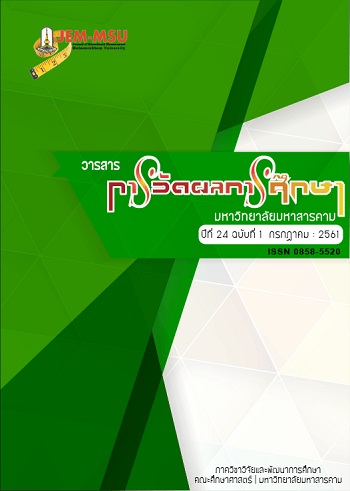Concepts, Principles and Strategies of Assessment for Learning
Main Article Content
Abstract
Assessment is one that is relevant to the instruction without any separation. For this
reason, the concept of assessment is likely to change from the past which focused on
Assessment of Learning (AoL) to determine the learner's ability in grades into Assessment for
Learning (AfL) The purpose of assessment for learning is to make students change while
learning is in progress and to develop themselves to meet the goals. Assessment for learning
is a collection of empirical evidence which based on the learning process that occurs with the learner. It is designed to identify and diagnose learning problems, as well as provided
quality feedback to learners through a variety of assessments to better understand learners'
learning in all aspects. There leads to the improvement of student learning’s styles and
teaching methods for more effective. The implementation of concept of Assessment for
Learning consists of 8 strategies: 1) provide students with a clear and understandable vision
of learning target, 2) show examples of strong and weak works, 3) offer regular descriptive
feedback, 4) teach students to assess and to set learning goals by themselves, 5) design
lesson plans which focused on learning target, 6) integrating instruction and assessment,
7) teach students for focused themselves on learning revision and 8) Encourage learners to
have self-reflection and share their learning
Article Details
The content and information contained in the published article in the Journal of Educational Measurement Mahasarakham University represent the opinions and responsibilities of the authors directly. The editorial board of the journal is not necessarily in agreement with or responsible for any of the content.
The articles, data, content, images, etc. that have been published in the Journal of Educational Measurement Mahasarakham University are copyrighted by the journal. If any individual or organization wishes to reproduce or perform any actions involving the entirety or any part of the content, they must obtain written permission from the Journal of Educational Measurement Mahasarakham University.
References
กรุงเทพฯ: แดเน็กซ์ อินเตอร์คอร์ปอเรชั่น.
2. บุญเชิด ภิญโญอนันตพงษ์. (2554). การประเมินผลการเรียนรู้ที่เน้นผู้เรียนเป็นสำคัญ: แนวคิดและวิธีการ.
กรุงเทพฯ: อมรินทร์พริ้นติ้งแอนด์พับลิชชิ่ง.
3. วิจารณ์ พานิช. (2558). ประเมินเพื่อมอบอำนาจการเรียนรู้ (Embedded formative assessment).
กรุงเทพฯ: บริษัท สานอักษร จำกัด.
4. ราชบัณฑิตยสถาน. (2555). พจนานุกรมศัพท์ศึกษาศาสตร์. กรุงเทพฯ: อรุณการพิมพ์.
5. ราชบัณฑิตยสถาน. (2558). พจนานุกรมศัพท์ศึกษาศาสตร์ร่วมสมัย. กรุงเทพฯ: อรุณการพิมพ์.
6. สรัญญา จันทร์ชูสกุล. (2560). เอกสารประกอบการสอน รายวิชา 473 512 การวัดและประเมินผลทางการ
ศึกษาสำหรับครู. นครปฐม: คณะศึกษาศาสตร์ มหาวิทยาลัยศิลปากร. (อัดสำเนา)
7. Bartlett, J. (2015). Outstanding assessment for learning in the classroom. New York : Routledge.
8. Brookhart, S. M. (2015). Performance assessment : showing what students know and can
do. West Palm Beach : Learning Sciences International.
9. Burke, K. (2005). How to assess authentic learning. 4th ed Thousand Oaks, CA.: Corwin Press.
10. Chappuis, J., Stiggins, R., Chappuis, S & Arter, J. (2012). Classroom assessment for student
learning : Doing it right -using it well. 2nd ed. Boston: Pearson.
11. Earl, L. M. (2013). Assessment as learning: Using classroom assessment to maximize
student learning. 2nd ed. Thousand Oaks. CA: Corwin Press.
12. Hammerman, E. (2009). Formative assessment strategies for enhanced learning in
science, K-8 . Thousand Oaks, CA.: Corwin Press.
13. Issacs, T., Zara, C. and Herbert, G. with Coombs, S. and Smith, C. (2013). Key concept in
educational assessment. Thousand Oaks. CA: SAGE.
14. McMillan, J. H. (2014) Classroom assessment: Principles and practice for effective
standards-based instruction. 6 th ed. Boston: Pearson Education.
15. Stanley, T & Alig, J. (2014). The school leader's guide to formative assessment : using data
to improve student and teacher achievement. New York : Routledge.


